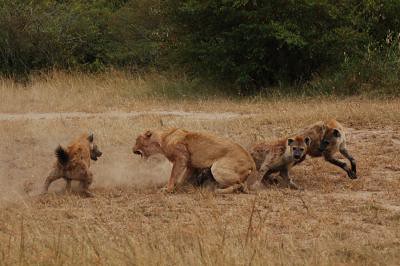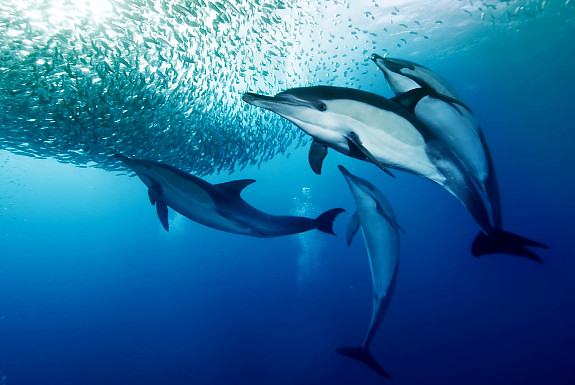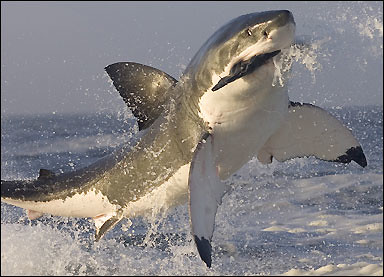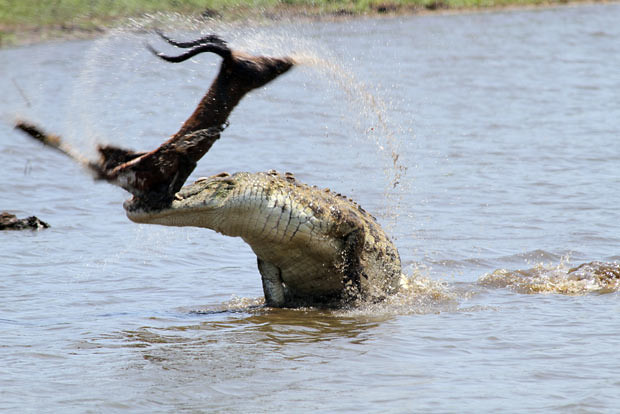Nature’s Most Skilled Hunters
June 20, 2011
by Brent McNamee
Showcasing sharp intelligence and amazingly sophisticated hunting methods, let’s look at some skills you may not learn during your hunter safety course and take an in-depth look at the fascinating hunting techniques of nature’s most skilled hunters.
1. Hyenas

Hyenas are highly intelligent creatures, perhaps even as smart as certain apes, some scientists believe. Hyenas hunt in packs, which are usually female-led. They also tend to hunt in opportune conditions where their prey will be most vulnerable, such as at night or during thunderstorms, when the prey is more prone to slip. When hyenas spot their prey they target the weakest and most vulnerable creature from the group and separate it from its herd. That’s when the hyena clan zones in and conquers.
They have a heart that is twice the size of a lion’s, making them resilient runners and excellent persistence hunters able to chase most of their prey into exhaustion.
Watch video:
2. Dolphins

A pod of as many 500 dolphins can band together at feeding time. Dolphins rely on each other to find food, communicating through clicks and squeaks. Their diet consists mainly of fish, squid, shrimp and sea plants. Adult dolphins can weigh about 500 pounds and consume over 14 pounds of fish per day.
With their sonar, dolphins scan the waters far ahead to find their prey. They conserve their energy by working as a group and use one of their two group hunting methods: herding or corralling. Corralling is a technique where the pod of dolphins drive the school of fish they are hunting upwards towards the surface of the water where the fish are most vulnerable, and where the dolphins will then take turns feeding. Herding is when a group of dolphins surrounds a school of fish and packs them as tightly as possible into a whirlpool of doom. In their social nature, dolphins take turns to go through the school and feed one at the time while the others keep the school of fish as tightly packed as possible.
Watch video:
3. Sharks

Sharks have a heightened sense of smell, not only through their nose but their entire bodies by means of nerve-packed strips running down their sides. Their extraordinary senses are what help them track and hunt their prey.
The Great White Shark is known as the world’s largest predatory fish and researchers claim that it has similar killing habits as human serial killers. Recent studies have indicated that many species possess powerful problem-solving skills, social skills and curiosity/
They lurk out of sight and stalk their victims, typically seals. They get close enough to scan their prey and figure out their movements but ensure a safe distance where they won’t get noticed. Considering their large size, they can be as far as 328 feet from their prey at a water depth of 82 feet without being detected. Then, once they are ready to attack, they emerge from the deepwater with fierce speed and momentum. The great white will then either swallow small prey whole or take huge bites out of larger animals like the seal.
Many sharks are cooperative feeders and hunt in packs to herd and capture prey.
Watch video:
4. Killer Whales

Killer whales or orcas feed off various species including other large whales, sharks or marine mammals like sea lions. Although sea lions hang close the shore, the killer whale will go right up to the shore to feast even if it is detrimental to their safety. They hunt as a gang with as many as 8 members and are sometimes called the “wolves of the sea” because of their group hunting methods, akin to wolf packs. On average, a killer whale eats 227 kilograms (500 lb) each day.
When on the hunt, killer whales track prey using echo location (sonar), basically following the sound to read how waves bounce back and in turn locate prey. Once the victim is in range, they circle and herd before going in for the deadly rampage. Once the victim has been targeted, they’ll toss, slap stun and torture it. This barbaric method is actually employed in order to avoid injury and disable their prey.
Watch video:
5. Chimpanzees

Though we don’t often associate our banana-loving cousins as big meat eaters, chimps consume several hundred pounds of meat in a single year. Jane Goodall was the first to observe wild chimpanzees hunting and eating meat. They eat it not only to nourish themselves but also means of creating political bonds and impress sexually receptive females.
When the craving for blood strikes, they can go on hunting ventures that last for days. They hunt in packs consisting of a few dozen members, females and juveniles included. The hunt is usually led by one skilled “stalker” who guides his gang of ravenous chimps towards their target. Males are especially aggressive and highly territorial, and will kill other chimps if they feel threatened. Chimpanzees also display cannibalistic behaviour and have been known to eat other monkeys.
Watch video:
6. Crocodiles

Crocodiles practice what is called mobbing when they hunt. This is a form of temporary social hunting where a group of crocs that live in close proximity will band together to conquer vulnerable prey. Nile crocodiles work 'co-operatively' to dismember carcasses and have also been seen carrying prey items together.
Crocodiles are ambush hunters, meaning they wait for their prey to come close, then rush out to attack. These deceiving hunters may appear to move slowly but can actually move very fast over short distances, even out of water.
They snatch victims from the water’s edge and drag them under to drown them. Despite their giant, sharp teeth, crocodiles can't actually chew, but spin around in order to break the victim’s body into pieces. They have the strongest jaw bite of any animal. The pressure of the crocodile's bite is more than 5,000 pounds per square inch! However, their neck is not so versatile with very limited side-to-side capabilities.
Watch video: